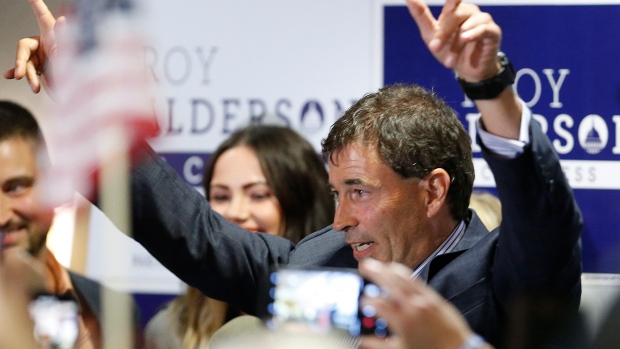Aug 8, 2018
Trump's candidate clings to narrow lead in ominous race for GOP
, Bloomberg News

U.S. President Donald Trump’s candidate was clinging to the lead in special-election for an Ohio House district Republicans have dominated since 1982 — but by a wafer-thin margin indicative of a political climate that threatens the party’s House majority in November.
With all precincts reporting, Troy Balderson led Democrat Danny O’Connor by just 1,754 votes — less than 1 per cent of the votes cast — for the suburban Columbus seat, according to the Ohio secretary of state’s office. But still to be counted were several thousand provisional ballots, a process that will take at least 10 days.
Balderson and Trump claimed victory, but O’Connor didn’t concede defeat. Whatever the final outcome, the two candidates will get a rematch to win a full term on Nov. 6 when the entire House and one-third of the Senate are on the general election ballot.
The narrow margin is ominous for the GOP because there are 68 Republican-held House districts that have voting patterns more favorable to Democrats than Ohio’s 12th district, according to a calculation by the nonpartisan Cook Political Report. Democrats need a net gain of 23 seats to take control of the House.
Warning to Republicans
“This race should not have even been a contest,” Charlie Dent, a former GOP representative from Pennsylvania who retired in May, said on CNN. He called it a “significant under-performance” for his party that foreshadows a wipeout for many of his former colleagues in November. “If I’m a Republican in a swing or marginal district right now, I’m very concerned.”
The Ohio special election was the most watched contest of a day in which primaries for state and federal offices were held in Michigan, Kansas, Missouri and Washington.
Republicans pulled out the stops to hang on to the Ohio seat, which was left open in January by the resignation of former Representative Pat Tiberi, who won the district by an average of 35 points in every election since it was redrawn after the 2010 census. In 2016, Trump carried it by 11 points.
Trump campaigned for Balderson in the district on Saturday, and sent a tweet on Tuesday urging voters to turn out and disparaging O’Connor. Vice President Mike Pence visited the district to back Balderson, who also was supported by Ohio’s GOP governor, John Kasich, and the state’s Republican senator, Rob Portman.
Outside Spending
Outside groups backing Balderson or opposing O’Connor had spent $5.2 million on the race, while those backing O’Connor or opposing Balderson spent US$1 million.
Trump took credit for Balderson’s victory via Twitter Tuesday night and congratulated him.
Claiming victory, Balderson said he’s “very honored” to represent the 12th district, thanking his parents, campaign volunteers, and Trump. “America is on the right path,” he said. “Over the next three months, I’m going to do everything I can to keep America great again.”
O’Connor said in a statement that “we don’t know the results quite yet” but that “there’s a lot at stake this November” for the district.
Still Uncounted
The ballots still to be counted include 1,349 provisional ballots in Franklin County, the most populous in the district, according to the country elections board, and where O’Connor had his best showing. There are 2,000 provisional votes in other counties. They are cast by voters who move and don’t update their registration or don’t appear in poll books for some reason.
In Ohio, provisional ballots can’t be counted for 10 days to allow for voter eligibility to be verified. State law calls for an automatic recount if the margin is less than 0.5 per cent of the total vote cast.
There are also 5,048 ballots that were sent out to voters who requested them that haven’t been returned. As long as a ballot is postmarked by Aug. 6 and received by the county elections board by Aug. 17, it can be counted.
Although the district was long viewed as a GOP stronghold, it shares some of the characteristics of suburban areas being targeted by Democrats to flip control of the House, primarily a significant concentration of white, college-educated, relatively high-income voters in the suburbs who have turned away from Trump.
Trump Factor
“The chaos that seems to surround Donald Trump has unnerved a lot of people. So suburban women in particular here are the ones that are really turned off,” Kasich, a moderate Republican and Trump critic, said Sunday on ABC’s “This Week” program. “It’s really kind of shocking because this should be just a slam dunk and it’s not.”
An energized Democratic base and lack of support from those traditionally GOP voters could tip the balance of the House. The voting patterns in some Republican-held districts -- including those of Virginia’s Barbara Comstock, Illinois’s Peter Roskam and California’s Dana Rohrabacher -- are less favorable to the GOP than Ohio’s 12th district.
“I’m sure Republicans will celebrate tonight, but a 1-point victory in that district is nothing to commend,” Republican pollster Frank Luntz said on Twitter. “The GOP have to do something really significant in September if they want to keep the House in November.”
While both candidates benefited from outside help, Republicans spent heavily to avoid a loss. Balderson and groups backing him ran a combined 6,686 broadcast television commercials from May 9 -- the day after the Ohio primary -- through Aug. 6, according to data from Kantar Media’s CMAG, which tracks political advertising. O’Connor and groups supporting him ran 3,868 during that same period. The Congressional Leadership Fund, which is aligned with House Speaker Paul Ryan and the chamber’s Republican hierarchy, was the single biggest advertiser, running 3,653 spots.
Message Switch
Republicans in the Ohio contest — much like in the Pennsylvania House special election in March — largely abandoned their messaging touting the tax law in favor of TV ads highlighting critiques of illegal immigration and the “liberal resistance.” It’s a sign that they view their voters as more driven by cultural rather than fiscal issues.
In the other contests on Tuesday, Democratic women enjoyed big victories in primaries on Tuesday, most notably in races to be the next governor of Michigan and Kansas.
In Michigan, the Democratic nomination for governor was won by Gretchen Whitmer, a former state legislator who was backed by Emily’s List, a group that supports Democratic women. She defeated Shri Thanedar, a wealthy entrepreneur, and Abdul El-Sayed, a progressive backed by Senator Bernie Sanders and Democratic congressional candidate Alexandria Ocasio-Cortez of New York, who ousted a powerful incumbent in a June primary.
It was a proxy war between competing wings of the Democratic Party, both of which have scored victories in the 2018 primaries.
She’ll face Bill Schuette, the Republican attorney general of Michigan, in the fall election.
In Kansas, Democrat Laura Kelly, a state senator, defeated four men to win the nomination to face Kris Kobach in the general election.
On the Republican side, the race was too close to call. Kobach, a polarizing candidate who is backed by Trump, was locked in a tight race with incumbent Republican Governor Jeff Colyer for the nomination. With 84 per cent of the vote counted, Kobach led by a margin of just 0.2 per cent of all ballots cast.
Missouri’s U.S. Senate race was officially set when Democratic incumbent Claire McCaskill and Republican state Attorney General Josh Hawley won their parties’ nominations, as expected. The state is a top GOP target in the party’s quest to expand its narrow 51-49 majority.
In Washington state, Democrat Maria Cantwell won renomination for a fourth term; she’s the favorite against Republican Susan Hutchison .
--With assistance from John McCormick and Mark Niquette.







